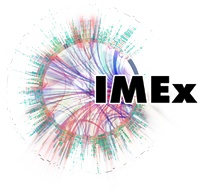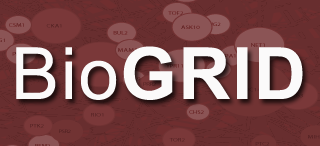
Protein–protein interactions (PPIs) are physical contacts of high specificity established between two or more protein molecules as a result of biochemical events steered by interactions that include electrostatic forces, hydrogen bonding and the hydrophobic effect. Many are physical contacts with molecular associations between chains that occur in a cell or in a living organism in a specific biomolecular context.
Biomedical text mining refers to the methods and study of how text mining may be applied to texts and literature of the biomedical domain. As a field of research, biomedical text mining incorporates ideas from natural language processing, bioinformatics, medical informatics and computational linguistics. The strategies in this field have been applied to the biomedical literature available through services such as PubMed.
BioCreAtIvE consists in a community-wide effort for evaluating information extraction and text mining developments in the biological domain.
The Human Protein Reference Database (HPRD) is a protein database accessible through the Internet. It is closely associated with the premier Indian Non-Profit research organisation Institute of Bioinformatics (IOB), Bangalore, India. This database is a collaborative output of IOB and the Pandey Lab of Johns Hopkins University.
The Saccharomyces Genome Database (SGD) is a scientific database of the molecular biology and genetics of the yeast Saccharomyces cerevisiae, which is commonly known as baker's or budding yeast. Further information is located at the Yeastract curated repository.
The Database of Interacting Proteins (DIP) is a biological database which catalogs experimentally determined interactions between proteins. It combines information from a variety of sources to create a single, consistent set of protein–protein interactions. The data stored within DIP have been curated, both manually, by expert curators, and automatically, using computational approaches that utilize the knowledge about the protein–protein interaction networks extracted from the most reliable, core subset of the DIP data. The database was initially released in 2002. As of 2014, DIP is curated by the research group of David Eisenberg at UCLA.

Ankyrin repeat domain-containing protein 13C is a protein that in humans is encoded by the ANKRD13C gene.
The Eukaryotic Linear Motif (ELM) resource is a computational biology resource for investigating short linear motifs (SLiMs) in eukaryotic proteins. It is currently the largest collection of linear motif classes with annotated and experimentally validated linear motif instances.

In molecular biology, STRING is a biological database and web resource of known and predicted protein–protein interactions.
MatrixDB is a biological database focused on molecular interactions between extracellular proteins and polysaccharides. MatrixDB takes into account the multimeric nature of the extracellular proteins. The database was initially released in 2009 and is maintained by the research group of Sylvie Ricard-Blum at UMR5246, Claude Bernard University Lyon 1.
The Death Domain database is a secondary database of protein-protein interactions (PPI) of the death domain superfamily. Members of this superfamily are key players in apoptosis, inflammation, necrosis, and immune cell signaling pathways. Negative death domain superfamily-mediated signaling events result in various human diseases which include, cancers, neurodegenerative diseases, and immunological disorders. Creating death domain databases are of particular interest to researchers in the biomedical field as it enables a further understanding of the molecular mechanisms involved in death domain interactions while also providing easy access to tools such as an interaction map that illustrates the protein-protein interaction network and information. There is currently only one database that exclusively looks at death domains but there are other databases and resources that have information on this superfamily. According to PubMed, this database has been cited by seven peer-reviewed articles to date because of its extensive and specific information on the death domains and their PPI summaries.
Cancer systems biology encompasses the application of systems biology approaches to cancer research, in order to study the disease as a complex adaptive system with emerging properties at multiple biological scales. Cancer systems biology represents the application of systems biology approaches to the analysis of how the intracellular networks of normal cells are perturbed during carcinogenesis to develop effective predictive models that can assist scientists and clinicians in the validations of new therapies and drugs. Tumours are characterized by genomic and epigenetic instability that alters the functions of many different molecules and networks in a single cell as well as altering the interactions with the local environment. Cancer systems biology approaches, therefore, are based on the use of computational and mathematical methods to decipher the complexity in tumorigenesis as well as cancer heterogeneity.
The Expression Atlas is a database maintained by the European Bioinformatics Institute that provides information on gene expression patterns from RNA-Seq and Microarray studies, and protein expression from Proteomics studies. The Expression Atlas allows searches by gene, splice variant, protein attribute, disease, treatment or organism part. Individual genes or gene sets can be searched for. All datasets in Expression Atlas have its metadata manually curated and its data analysed through standardised analysis pipelines. There are two components to the Expression Atlas, the Baseline Atlas and the Differential Atlas:

Uncharacterized protein C14orf80 is a protein which in humans is encoded by the chromosome 14 open reading frame 80, C14orf80, gene.
The human interactome is the set of protein–protein interactions that occur in human cells. The sequencing of reference genomes, in particular the Human Genome Project, has revolutionized human genetics, molecular biology, and clinical medicine. Genome-wide association study results have led to the association of genes with most Mendelian disorders, and over 140 000 germline mutations have been associated with at least one genetic disease. However, it became apparent that inherent to these studies is an emphasis on clinical outcome rather than a comprehensive understanding of human disease; indeed to date the most significant contributions of GWAS have been restricted to the “low-hanging fruit” of direct single mutation disorders, prompting a systems biology approach to genomic analysis. The connection between genotype and phenotype remain elusive, especially in the context of multigenic complex traits and cancer. To assign functional context to genotypic changes, much of recent research efforts have been devoted to the mapping of the networks formed by interactions of cellular and genetic components in humans, as well as how these networks are altered by genetic and somatic disease.

The International Molecular Exchange Consortium (IMEx) is a group of the major public providers of molecular interaction data to provide a single, non-redundant set of molecular interactions. Data is captured using a detailed curation model and made available in the PSI-MI standard formats. Participating databases include DIP, IntAct, the Molecular Interaction Database (MINT), MatrixDB, InnateDB, IID, HPIDB, UCL Cardiovascular Gene Annotation, MBInfo, Molecular Connections and UniProt. The group collates the interaction data and prevents duplicate entries in the various databases. The IMEx consortium also supports and contributes to the development of the HUPO-PSI-MI XML format, which is now widely implemented.
A proteolysis targeting chimera (PROTAC) is a heterobifunctional molecule composed of two active domains and a linker, capable of removing specific unwanted proteins. Rather than acting as a conventional enzyme inhibitor, a PROTAC works by inducing selective intracellular proteolysis. PROTACs consist of two covalently linked protein-binding molecules: one capable of engaging an E3 ubiquitin ligase, and another that binds to a target protein meant for degradation. Recruitment of the E3 ligase to the target protein results in ubiquitination and subsequent degradation of the target protein via the proteasome. Because PROTACs need only to bind their targets with high selectivity, there are currently many efforts to retool previously ineffective inhibitor molecules as PROTACs for next-generation drugs.
The Histone Database is a comprehensive database of histone protein sequences including histone variants, classified by histone types and variants, maintained by National Center for Biotechnology Information. The creation of the Histone Database was stimulated by the X-ray analysis of the structure of the nucleosomal core histone octamer followed by the application of a novel motif searching method to a group of proteins containing the histone fold motif in the early-mid-1990. The first version of the Histone Database was released in 1995 and several updates have been released since then.

Transmembrane protein 255A is a protein that is encoded by the TMEM255A gene. TMEM255A is often referred to as family with sequence similarity 70, member A (FAM70A). The TMEM255A protein is transmembrane and is predicted to be located the nuclear envelope of eukaryote organisms.






